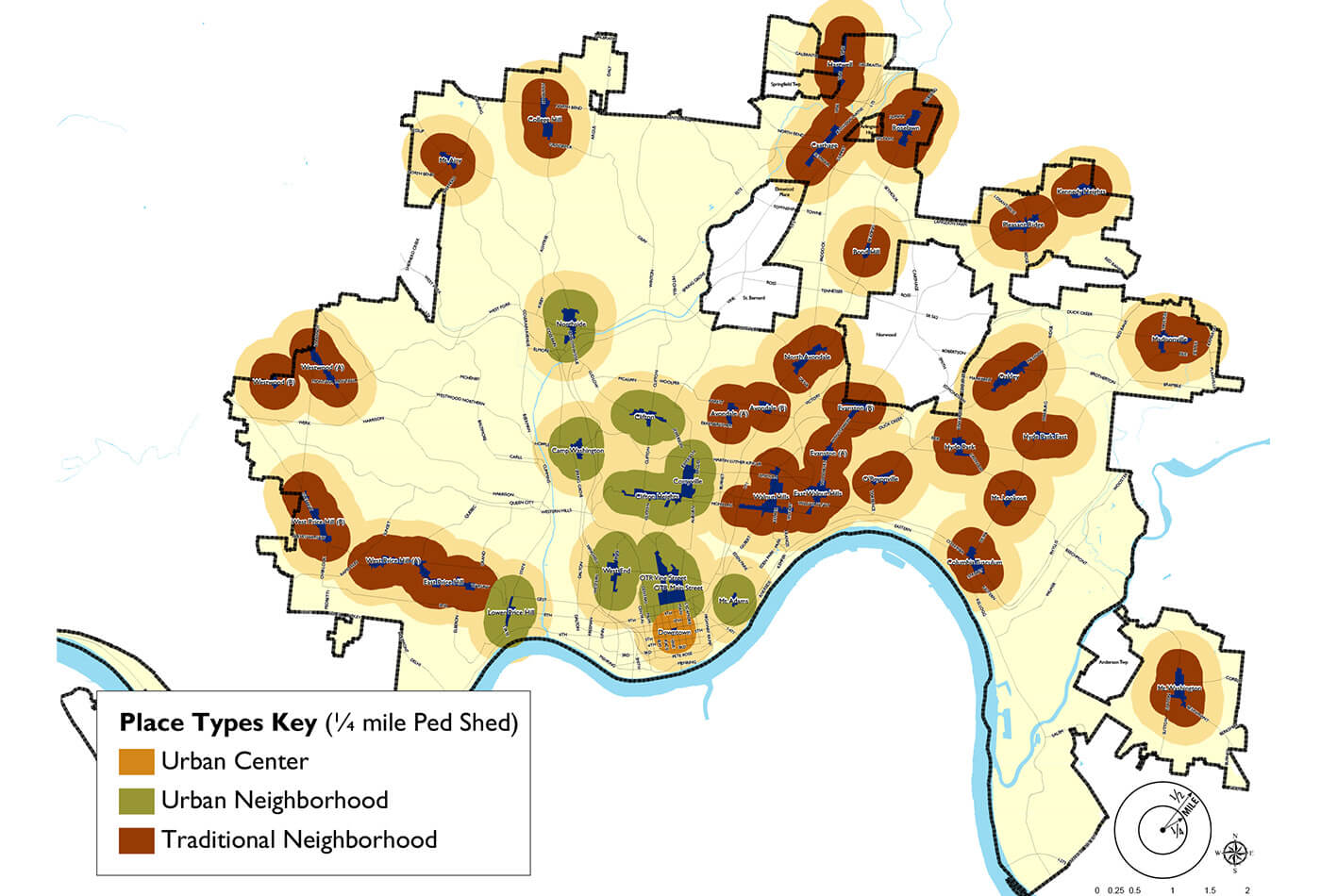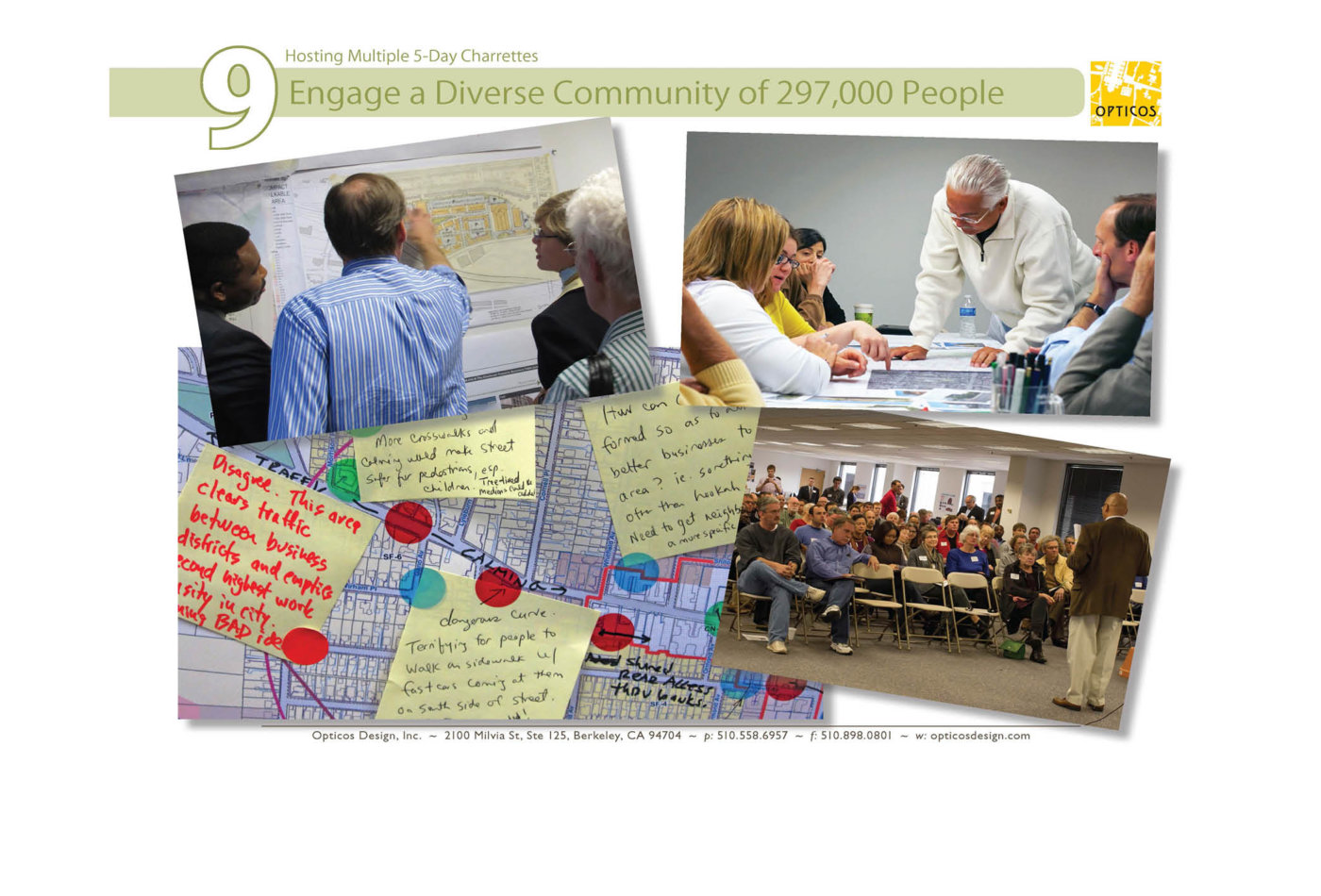-
Award
2014 CNU Charter Award Grand Prize for Best Planning Tool or Process; 2014 National APA Burnham Award for Comprehensive Plans; 2014 Driehaus Form-Based Code Award
-
Size
Citywide, encompassing 42 walkable neighborhoods
-
Community Engagement
Several multiday charrettes, including a five-day citywide charrette attended by over 600 people
Cincinnati Citywide Form-Based Code and Comprehensive Plan Land Use Framework
Cincinnati, Ohio
For over four years, Opticos worked with the City of Cincinnati to put a framework in place to achieve the city’s number-one goal: to build thriving communities that would bring people and businesses back into the urban core. Beginning with a citywide Form-Based Code, our work expanded to include strategic advising and the creation of a place- and form-based approach to the Comprehensive Plan. Eventually, this will become one of the largest applications of Form-Based Coding in the United States.
A diamond in the Rust Belt
The Cincinnati metropolitan area is home to more than 2.1 million people, but this city has lost more than 40% of its residents since 1950. Urban neighborhoods struggle with disinvestment and low, suburban densities. Over 10,000 historic buildings need renovation.
The good news is that – like many other Rust Belt cities – Cincinnati has a tremendous opportunity. They city’s older neighborhoods boast a wide variety of urban housing types, including some of the best collections of Missing Middle Housing in the country. The homes are built around a network of neighborhood main streets, with easily accessible open spaces that help create community. It is a rich, diverse and well-built collection of historic architecture, ready and waiting to be brought back to life.
“Opticos was an invaluable partner in helping Cincinnati achieve its goal of ‘Thriving Re-Urbanization.’”
— Roxanne Qualls, Former Mayor, Cincinnati, Ohio
How a citywide Form-Based Code can revitalize urban neighborhoods
Cincinnati had a Comprehensive Plan already in place, and the primary objective was to achieve “thriving re-urbanization.” It was immediately clear that a form-based approach to zoning would be necessary to help the city achieve its goal.
With strong leadership from Vice Mayor Roxanne Qualls and Planning Director Charles Graves, the city embarked on the creation of a Form-Based Code. The effort was funded by a Community Challenge Planning Grant, which was given to the city by the Department of Housing and Urban Development (HUD). Four pilot neighborhoods were mapped with the Form-Based Code, and when the remaining 38 neighborhoods are mapped, this effort will represent one of the largest applications of Form-Based Coding in the country.
Using the urban-to-rural transect as the organizing principle for the code, the team completed extensive photo documentation to calibrate the transect and ensure that it would reinforce the unique characteristics of Cincinnati’s urban neighborhoods. Thoroughfare standards were integrated into the Form-Based Code and a Complete Streets document was assembled to ensure that the right decisions were being made on a citywide scale, to improve walkability everywhere.

Engaging the diverse community
An important part of the process was extensive community engagement. In addition to several years of general Form-Based Code education and outreach – including staff attendance at courses hosted by the Form-Based Codes Institute – Opticos used two, five-day charrette processes that engaged the community and generated excitement about the Form-Based Code.
Bridging the Form-Based Code and Comprehensive Plan efforts
A Comprehensive Plan update, Plan Cincinnati, started shortly after the FBC effort began. The city leadership asked the Opticos team to introduce a form-based approach to Plan Cincinnati that would link it more directly to the Form-Based Coding (FBC) effort. We introduced a community types/place types approach to the Comprehensive Plan, and a placemaking lexicon of the urban-to-rural transect, building types, thoroughfare types, and frontage types. This became the bridge between the Comprehensive Plan and FBC efforts.
Prioritizing investment in walkable urban spaces
Critically, the city wanted to ensure that public and private investment in walkable urban places became a priority. To achieve this, we classified and differentiated walkable urban places and drivable suburban places within the entire city. A framework of 42 walkable urban neighborhoods was defined, and these neighborhoods became the priority for the Form-Based Code.
The results
The City of Cincinnati unanimously adopted the Form-Based Code in 2013. Since then, the city has seen a resurgence in infill and redevelopment in the pilot neighborhoods, with urban development under construction in neighborhoods that have long been missing private sector investment. In 2016 alone, the city reported the creation of over 800 housing units in these areas.
Together, these tools have helped Cincinnati evolve, providing a successful model for other cities seeking improved livability, walkability, and economic opportunity to follow.
“Opticos’ work has been invaluable for the City of Cincinnati in providing a coherent Form-Based Code implementation strategy. They effectively educated our staff and community members, assessed our current code, and provided several implementation options for us to consider. In addition, they are providing an innovative form-based framework for our Comprehensive Plan that will reinforce the unique community character of the walkable urban neighborhoods throughout the city and provide a foundation for the future Form-Based Code work.”
— Charles Graves, Director, Planning and Building, City of Cincinnati















